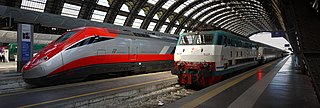
The Italian railway system is one of the most important parts of the infrastructure of Italy, with a total length of 24,227 km (15,054 mi) of which active lines are 16,723 km. The network has recently grown with the construction of the new high-speed rail network. Italy is a member of the International Union of Railways (UIC). The UIC Country Code for Italy is 83.

The Val d'Orcia or Valdorcia is a region of Tuscany, central Italy, which extends from the hills south of Siena to Monte Amiata. Its gentle, cultivated hills are occasionally broken by gullies and by picturesque towns and villages such as Pienza, Radicofani and Montalcino. Its landscape has been depicted in works of art from Renaissance painting to modern photography.
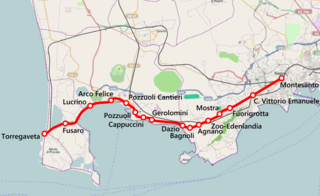
The Cumana railway is a commuter railway in Campania, southern Italy, connecting Naples by two separate routes with Torregaveta, near Cuma in the town of Bacoli. It passes through Pozzuoli and the volcanic Campi Flegrei area. The line was built and run by the Società per le Ferrovie Napoletane, founded in 1883, and is now operated by the Ente Autonomo Volturno (EAV) company.

The Italian railway system is one of the most important parts of the infrastructure of Italy, with a total length of 24,227 km (15,054 mi) as of 2011.

The Florence–Rome railway is part of the traditional main north–south trunk line of the Italian railway network. The line is referred to by Ferrovie dello Stato as the Linea Lenta to distinguish it from the parallel high-speed line. The Linea Lenta is now mainly used for regional services, for the InterCity services — rather than the faster Le Frecce trains — between Florence and Rome and for the majority of freight trains. Some types of passenger train are routed on the line to serve smaller stations not served by the high-speed line or in order to improve traffic flow during peak periods or other periods of congestion.

The Livorno–Rome railway is one of the trunk lines of the Italian railway network. It connects Italy’s northwest with its south, running along the Tyrrhenian coast between the Italian regions of Tuscany and Lazio, through the provinces of Livorno, Grosseto, Viterbo and Rome. The line is double track and is fully electrified at 3,000 V DC. Passenger traffic is managed by Trenitalia.
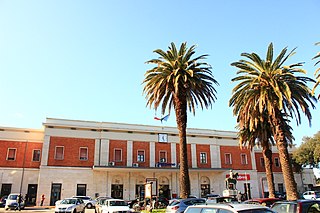
Grosseto railway station is the main station serving the city and comune of Grosseto, in the region of Tuscany, central Italy. Opened in 1864, it forms part of the Pisa–Livorno–Rome railway.

Siena railway station serves the city and comune of Siena, in the region of Tuscany, central Italy. Opened in 1935, it is the terminus of the lines to Empoli, to Chiusi and to Grosseto via Monte Antico.

L'Aquila railway station serves the city and comune of L'Aquila, in the region of Abruzzo, southern Italy. Opened in 1875, it forms part of the Terni–Sulmona railway.

Taranto railway station is the main station serving the city and comune of Taranto, in the region of Apulia, southern Italy. Opened in 1868, it forms a junction between three main lines, from Bari, Brindisi and Reggio di Calabria, respectively. It is also a terminus of a secondary line, the Bari–Martina Franca–Taranto railway.

Treviglio railway station, also known as Treviglio centrale railway station is the main station serving the town and comune of Treviglio, in the region of Lombardy, northern Italy. Opened in 1878, it has a higher average number of passengers per day than Treviglio's other railway station, Treviglio Ovest.
The Rome–Ancona railway is a rail line in central Italy connecting the city of Ancona with Orte, and therefore with the capital city, Rome. The line crosses the Apennine Mountains from the Adriatic Sea to the Tyrrhenian Sea, passing through Foligno, Spoleto, and Terni.

The Milan–Asso railway is a regional railway line with standard track gauge which links Milan to Canzo crossing for Erba and other towns in Brianza. The most northern terminal is the station of Canzo-Asso, which is located in Canzo's territory but is commonly known as Asso in the short form. That, because there is another station on the line called Canzo station and Canzo-Asso is next to Asso's boundary and serves this commune too.

The Ferrovia Asciano–Monte Antico is a railway line linking the town of Asciano to Monte Antico in the municipality of Civitella Paganico in Southern Tuscany.
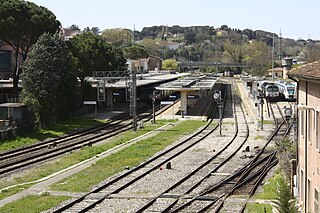
The Empoli–Siena–Chiusi railway is an Italian railway that connects Empoli and Siena to the Florence–Rome railway at Chiusi. The route between Empoli and Siena follows the valleys of Elsa river as far as Poggibonsi and then the Staggia stream, which were very convenient when the line was planned. The route is in fact flat and substantially straight from Empoli to Poggibonsi, then ascends with wide and long curves through the hills of central Tuscany to Siena.
The Naples–Foggia railway is an Italian railway line connecting Naples, in Campania, with Foggia, in Apulia, crossing the Apennines at the saddle of Ariano through a series of tunnels.

Monte Antico railway station is an Italian railway station on the Siena-Grosseto railway line in Southern Tuscany.
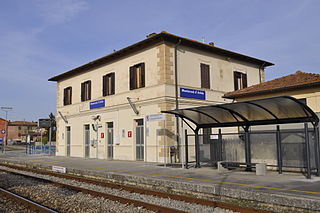
Monteroni d'Arbia railway station is an Italian railway station on the Siena-Grosseto railway line in Southern Tuscany.

Buonconvento railway station is an Italian railway station on the Siena-Grosseto railway line in Southern Tuscany.
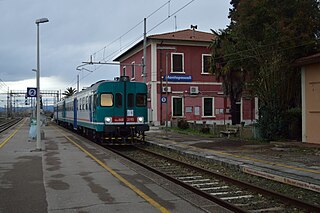
Montepescali railway station is an Italian railway station on the Tirrenica railway line, located in the village of Braccagni, at the bottom of the hill of Montepescali, near the city of Grosseto. It serves as a junction for services on the Siena-Grosseto line that connect here and follow the main line south into Grosseto.























